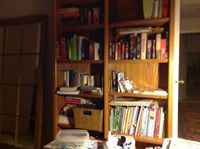In which state is it possible for the Sun to be directly overhead at local noon?
Zenith day or Lahiana Noon occurs twice per year at locations between the Tropics of Cancer and Capricorn which are ~23.5 degrees North and South of the Equator. In this region, there are two days per year where at the exact moment of local noon, vertical objects, such as flag poles, cast no shadow since the Sun is directly overhead. The precise date and time of Lahiana Noon will vary with geographic location. For locations in the Northern Hemisphere, Lahiana Noon occurs earlier for locations closer to the Equator. Along a given Tropic, the Lahiana Noon occurs precisely at local noon on the day of the Solstice and at the Equator, Lahiana occurs at local noon on the days of the Equinox.
Because the rotational axis of the Earth is tilted by ~23.5 relative to its orbital plane, the altitude of the Sun at noon varies throughout the year. If you live in the Northern Hemisphere, you no doubt have noticed that the Sun doesn't rise as high in the sky in the Winter as it does in the Summer. At local noon, the sun reaches its highest or Zenith position. In fact, sailors at sea use the Zenith altitude of the Sun to estimate their position.
Of all the 50 US States, only Hawaii lies within the Tropics and hence is the only US State to experience a Lahaina Noon between May 18 and July 24, shortly after Standard noon.
Incidentally, Lahiana means "cruel sun" in Hawaiian since the Sun is at its most intensity!
More Info:
en.wikipedia.org








